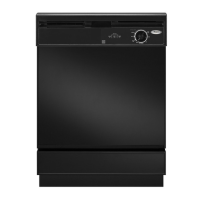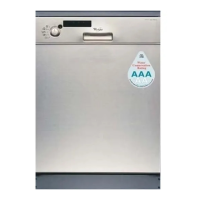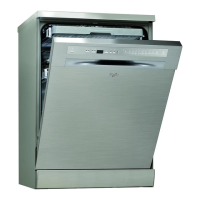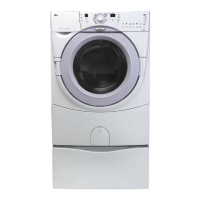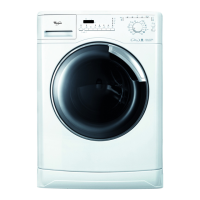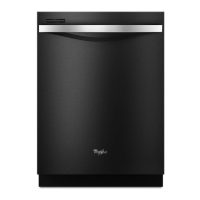Do you have a question about the Whirlpool 8000 Series and is the answer not in the manual?
Steps to prepare the dishwasher before the first use, including loading, checking spray arm, adding detergent, and checking rinse agent.
Guidance on selecting a drying option and cycle, and how the dishwasher starts automatically.
Procedure for adding dishes mid-cycle, ensuring proper washing and draining.
Instructions on how to change the selected wash cycle at any point during operation.
Details the double wash cycle for moderate to heavily soiled loads, with a cycle time of approximately 89 minutes.
Describes the single wash cycle for light to moderately soiled loads, with a cycle time of approximately 77 minutes.
A short cycle for rinsing items to be washed later, about 10 minutes long, without detergent.
Heats the air in the dishwasher during the drying phase for better results, often with rinse agent.
Dries dishes without heating the air, saving energy but taking longer and potentially causing spotting.
Instructions on preparing dishes for washing, removing large food pieces, and ensuring proper spray reach.
Guidelines for loading cups, glasses, and smaller items in the top rack for optimal cleaning and draining.
Advice for loading pots, pans, and dishes with dried-on food in the bottom rack, facing soiled surfaces inward.
Tips for loading a mix of items, ensuring pot handles don't obstruct the spray arm and large items don't block the spray tower.
Guidance on loading cookie sheets, cake pans, and other large items at the sides and back of the rack.
Instructions for loading forks, spoons, and knives to ensure proper cleaning without nesting.
Recommends using automatic dishwasher detergent only and discusses phosphorus content for water hardness.
Explains the two-section dispenser and how to fill it based on the wash cycle selected.
Provides guidance on the amount of detergent needed based on water hardness levels.
Explains the function of rinse agent in improving drying and preventing spots, and how to check levels.
Instructions on how to check if the rinse agent dispenser needs refilling, including on specific models.
Details on how to fill the rinse agent dispenser and precautions to avoid overfilling and excessive suds.
Emphasizes the importance of hot water (140°F/60°C) for effective washing and drying.
Provides advice to minimize noise during operation, such as securing items and avoiding contact.
Offers specific advice for washing various materials like aluminum, china, crystal, plastics, and wood.
Suggestions for conserving energy, including washing full loads and using the light wash cycle.
Instructions for cleaning the exterior surfaces using a soft cloth, mild detergent, or sponge.
Methods for cleaning the interior, addressing hard water mineral build-up with detergent paste.
Procedure for cleaning the filter system to remove collected particles, with a safety warning.
Addresses spotting and filming issues, suggesting detergent adjustments and vinegar rinses.
Troubleshooting for insufficient water temperature affecting wash performance and drying.
Covers problems related to using too little, too much, or old/improper dishwasher detergent.
Explains how incorrect loading can cause poor washing, spray blockage, and item damage.
Troubleshooting for spray arms that are not rotating freely, often due to improper loading.
Addresses glassware damage caused by improper loading, such as placing over prongs.
General advice for dishes not washing clean, including water temperature, loading, and detergent.
Identifies etching as a permanent corrosion and suggests reducing detergent or using low-phosphorus types.
Addresses discoloration due to iron or manganese in water, offering temporary and permanent solutions.
Explains rust spots from acidic foods and warns against mixing metals in the silverware basket.
Advice to avoid undissolved detergent contacting flatware, potentially causing spots or tarnish.
Describes silverplate wear revealing base metal, suggesting silver polish for removal.
Explains that some residual water is normal and helps keep seals from drying.
Discusses the importance of a clean drain air gap for proper dishwasher draining.
Provides a checklist of common problems and solutions that can be fixed without tools.
Offers telephone and mailing contact information for Whirlpool's Consumer Assistance Center.
Guides users on how to locate authorized Whirlpool service companies in their area.
Explains the importance and identification of FSP (Factory Specified Parts) for appliance repairs.
Advises contacting the Major Appliance Consumer Action Panel (MACAP) for unresolved problems.
Outlines what Whirlpool will pay for, including FSP parts and labor for defects within specified periods.
Lists situations and damages that are not covered by the Whirlpool dishwasher warranty.
Steps to prepare the dishwasher before the first use, including loading, checking spray arm, adding detergent, and checking rinse agent.
Guidance on selecting a drying option and cycle, and how the dishwasher starts automatically.
Procedure for adding dishes mid-cycle, ensuring proper washing and draining.
Instructions on how to change the selected wash cycle at any point during operation.
Details the double wash cycle for moderate to heavily soiled loads, with a cycle time of approximately 89 minutes.
Describes the single wash cycle for light to moderately soiled loads, with a cycle time of approximately 77 minutes.
A short cycle for rinsing items to be washed later, about 10 minutes long, without detergent.
Heats the air in the dishwasher during the drying phase for better results, often with rinse agent.
Dries dishes without heating the air, saving energy but taking longer and potentially causing spotting.
Instructions on preparing dishes for washing, removing large food pieces, and ensuring proper spray reach.
Guidelines for loading cups, glasses, and smaller items in the top rack for optimal cleaning and draining.
Advice for loading pots, pans, and dishes with dried-on food in the bottom rack, facing soiled surfaces inward.
Tips for loading a mix of items, ensuring pot handles don't obstruct the spray arm and large items don't block the spray tower.
Guidance on loading cookie sheets, cake pans, and other large items at the sides and back of the rack.
Instructions for loading forks, spoons, and knives to ensure proper cleaning without nesting.
Recommends using automatic dishwasher detergent only and discusses phosphorus content for water hardness.
Explains the two-section dispenser and how to fill it based on the wash cycle selected.
Provides guidance on the amount of detergent needed based on water hardness levels.
Explains the function of rinse agent in improving drying and preventing spots, and how to check levels.
Instructions on how to check if the rinse agent dispenser needs refilling, including on specific models.
Details on how to fill the rinse agent dispenser and precautions to avoid overfilling and excessive suds.
Emphasizes the importance of hot water (140°F/60°C) for effective washing and drying.
Provides advice to minimize noise during operation, such as securing items and avoiding contact.
Offers specific advice for washing various materials like aluminum, china, crystal, plastics, and wood.
Suggestions for conserving energy, including washing full loads and using the light wash cycle.
Instructions for cleaning the exterior surfaces using a soft cloth, mild detergent, or sponge.
Methods for cleaning the interior, addressing hard water mineral build-up with detergent paste.
Procedure for cleaning the filter system to remove collected particles, with a safety warning.
Addresses spotting and filming issues, suggesting detergent adjustments and vinegar rinses.
Troubleshooting for insufficient water temperature affecting wash performance and drying.
Covers problems related to using too little, too much, or old/improper dishwasher detergent.
Explains how incorrect loading can cause poor washing, spray blockage, and item damage.
Troubleshooting for spray arms that are not rotating freely, often due to improper loading.
Addresses glassware damage caused by improper loading, such as placing over prongs.
General advice for dishes not washing clean, including water temperature, loading, and detergent.
Identifies etching as a permanent corrosion and suggests reducing detergent or using low-phosphorus types.
Addresses discoloration due to iron or manganese in water, offering temporary and permanent solutions.
Explains rust spots from acidic foods and warns against mixing metals in the silverware basket.
Advice to avoid undissolved detergent contacting flatware, potentially causing spots or tarnish.
Describes silverplate wear revealing base metal, suggesting silver polish for removal.
Explains that some residual water is normal and helps keep seals from drying.
Discusses the importance of a clean drain air gap for proper dishwasher draining.
Provides a checklist of common problems and solutions that can be fixed without tools.
Offers telephone and mailing contact information for Whirlpool's Consumer Assistance Center.
Guides users on how to locate authorized Whirlpool service companies in their area.
Explains the importance and identification of FSP (Factory Specified Parts) for appliance repairs.
Advises contacting the Major Appliance Consumer Action Panel (MACAP) for unresolved problems.
Outlines what Whirlpool will pay for, including FSP parts and labor for defects within specified periods.
Lists situations and damages that are not covered by the Whirlpool dishwasher warranty.
| Type | Built-In |
|---|---|
| Number of Wash Cycles | 6 |
| Upper Rack Features | Adjustable |
| Lower Rack Features | Adjustable |
| Dishwasher Interior Material | Stainless Steel |
| Noise Level | Quiet |
| Energy Star Certified | Yes |
| Soil Sensor | Yes |
| Stainless Steel Tub | Yes |
| Delay Start | Yes |
| Heated Dry | Yes |




